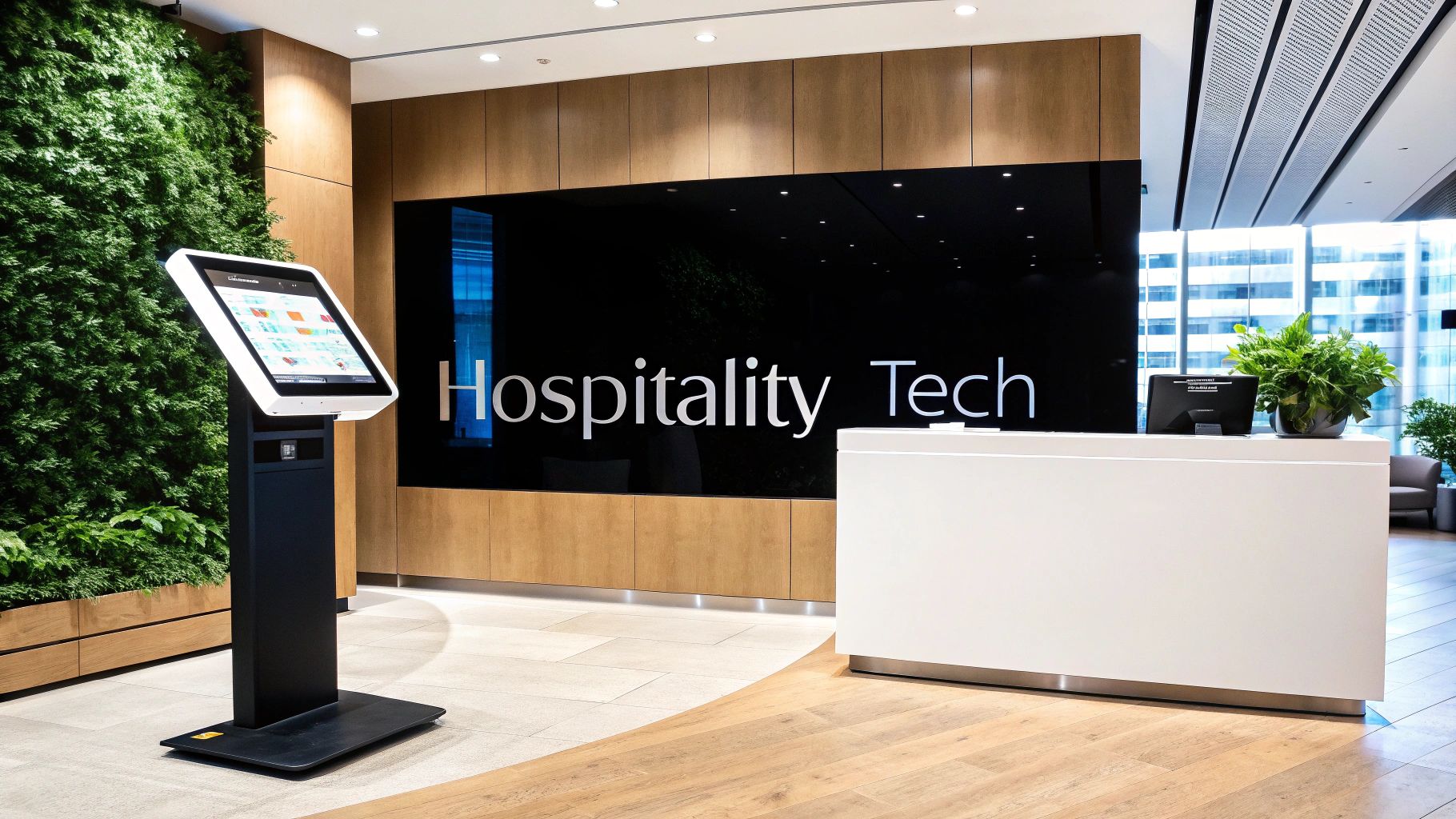The hospitality landscape is evolving at an unprecedented pace, driven by guest expectations for seamless, personalized, and connected experiences. Staying ahead means more than just offering great service; it requires a strategic embrace of innovation. This article explores the nine most impactful hospitality technology trends that are redefining operations, enhancing guest satisfaction, and boosting profitability for modern properties.
From AI-powered concierges and mobile key technology to fully integrated smart rooms and robotic service automation, these advancements are no longer futuristic concepts. They are essential tools for gaining a competitive edge. Understanding how these individual tools fit into a bigger picture is key; the broader context of digital transformation in hospitality shows how a cohesive tech strategy can fundamentally reshape a business from the ground up.
This guide provides a clear, actionable roadmap to the technologies shaping the next generation of hospitality. We will delve into what each trend means, its direct benefits, and practical steps for implementation. Let's explore the innovations that will define success in the years to come.
1. Artificial Intelligence and Chatbots
Artificial Intelligence (AI) and machine learning have become central to modern hospitality technology trends, primarily through the deployment of sophisticated chatbots and virtual assistants. These tools offer guests instant, 24/7 support by handling a wide range of tasks automatically, from booking dinner reservations and answering questions about amenities to processing service requests. By leveraging natural language processing, they provide conversational, human-like interactions that significantly reduce staff workload and improve response times.
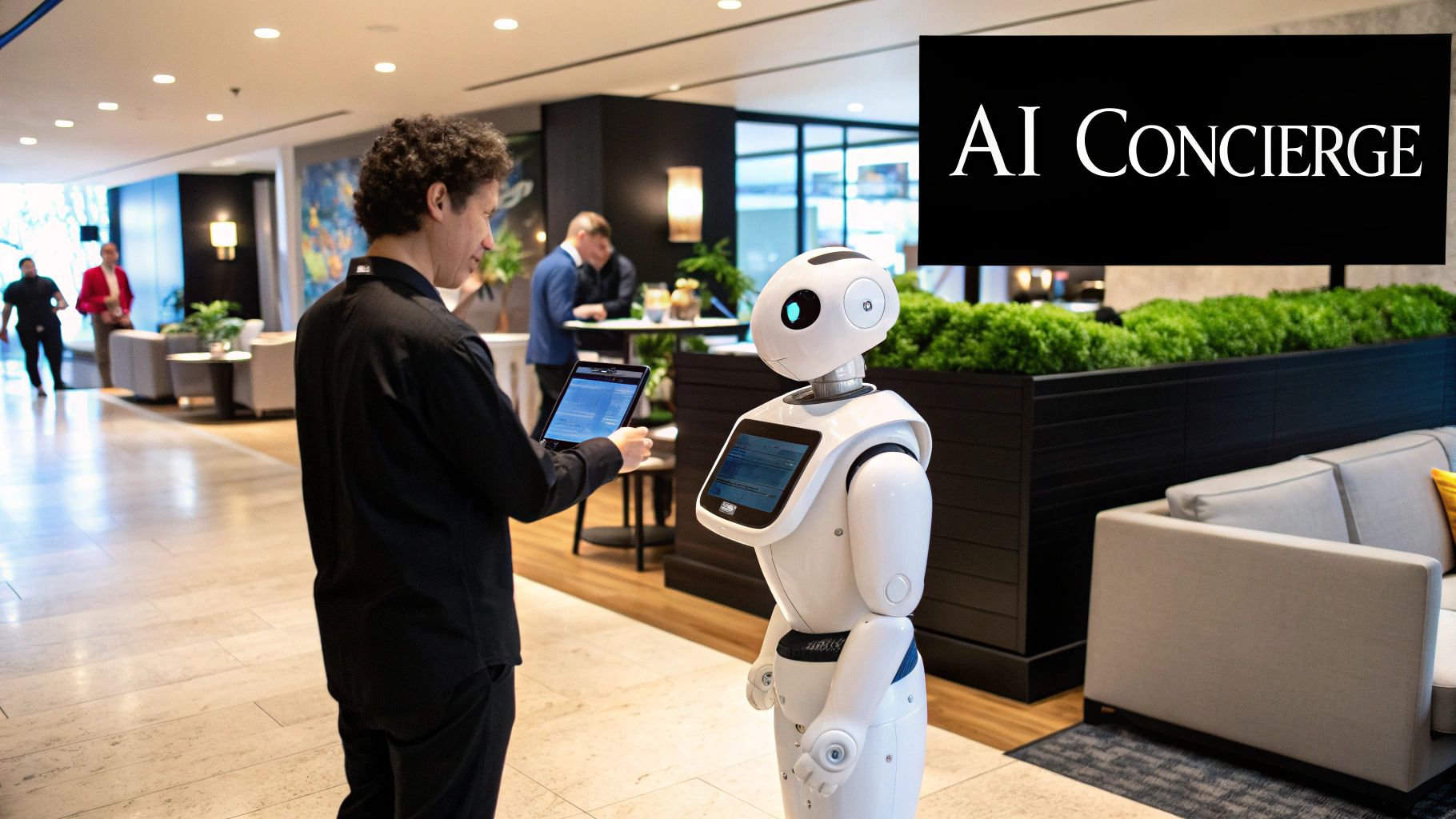
This technology isn't just about efficiency; it's a powerful tool for personalization. Chatbots can remember guest preferences, suggest tailored local activities, and proactively offer services, creating a more memorable and customized stay. By automating routine inquiries, they free up human staff to focus on more complex, high-touch interactions that require a personal approach. This strategic blend of automation and human service is a key way to improve guest satisfaction and loyalty.
Real-World Examples
Several major hotel brands have successfully integrated this technology. Hilton's "Connie" robot concierge, powered by IBM Watson, answers guest questions and provides recommendations. Similarly, The Cosmopolitan of Las Vegas introduced "Rose," a sassy chatbot that handles room service orders and offers curated city tours, creating a unique brand personality.
How to Implement AI Chatbots
- Start Small: Begin by programming the chatbot to handle your top 10-15 most frequently asked questions. This provides immediate value and minimizes initial complexity.
- Ensure Seamless Handoff: Design a clear and frictionless process for escalating a conversation to a human agent when the chatbot cannot resolve an issue.
- Analyze and Refine: Regularly review conversation logs and user feedback to identify gaps in the chatbot's knowledge base. Use this data to continuously improve its accuracy and capabilities.
2. Mobile Key Technology
Mobile key technology has become a cornerstone of modern hospitality technology trends, allowing guests to bypass the front desk and access their rooms using their smartphones. This contactless solution leverages Bluetooth or NFC technology through a dedicated hotel app to securely grant access, streamlining the check-in process and enhancing guest convenience. By eliminating traditional plastic key cards, hotels can offer a faster, more seamless arrival experience while also reducing operational costs and environmental waste associated with single-use cards.
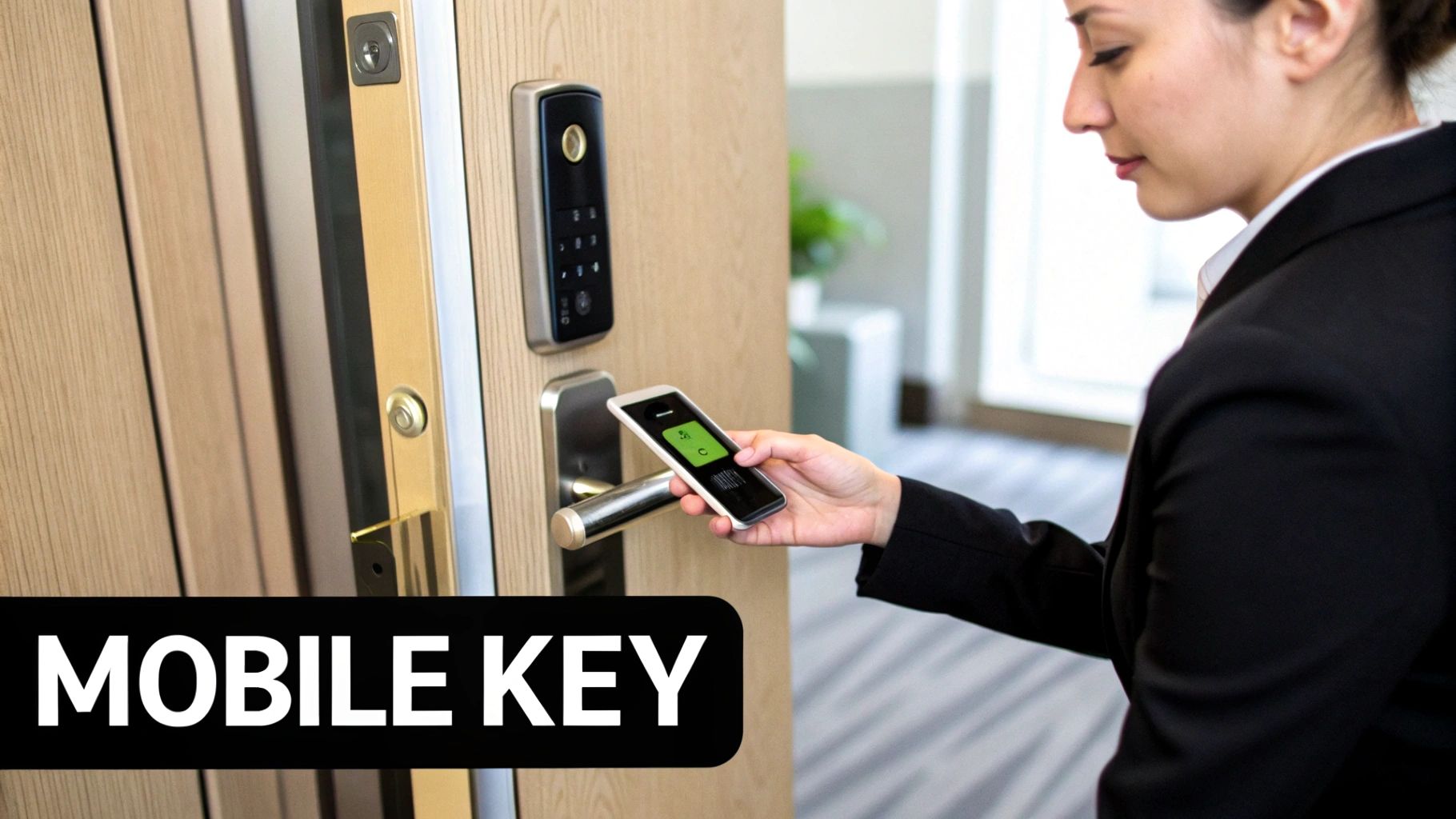
Beyond simple room access, mobile keys integrate directly into the guest journey, often housed within a hotel's branded app. This creates a powerful channel for direct communication, allowing properties to send personalized offers, upsell amenities, and gather real-time feedback. The technology not only meets the modern traveler's demand for digital-first solutions but also provides a secure and auditable entry system. This elevates the guest experience from a simple transaction to an integrated, tech-forward stay.
Real-World Examples
Major hotel chains have widely adopted this technology to enhance their guest services. Hilton's Digital Key and Marriott's Mobile Key are flagship examples, fully integrated into their loyalty apps and used across thousands of properties worldwide. Similarly, Starwood's SPG Keyless was a pioneering program that helped popularize the concept, proving its viability and appeal to tech-savvy travelers.
How to Implement Mobile Key Technology
- Provide Clear Setup Instructions: Guide guests through the app download and key activation process with simple, step-by-step instructions sent before their arrival.
- Maintain Traditional Key Backup: Always have physical key cards available for guests who are less comfortable with technology or experience device issues like a dead battery.
- Ensure Strong Wi-Fi Coverage: Reliable internet access is crucial for the initial download and activation of the mobile key, especially in lobbies and common areas.
- Test Compatibility Across Device Types: Thoroughly test the mobile key solution on a wide range of popular iOS and Android devices to ensure a smooth and consistent user experience for all guests.
3. Internet of Things (IoT) Integration
The Internet of Things (IoT) is a key hospitality technology trend that connects various hotel devices and systems to create smart, automated environments. This network of sensors and smart devices allows for real-time data collection and control, enabling everything from smart thermostats that adjust to a guest's presence to connected minibars that automatically report stock levels. The result is a seamless, responsive environment that enhances guest comfort while simultaneously optimizing operational efficiency.
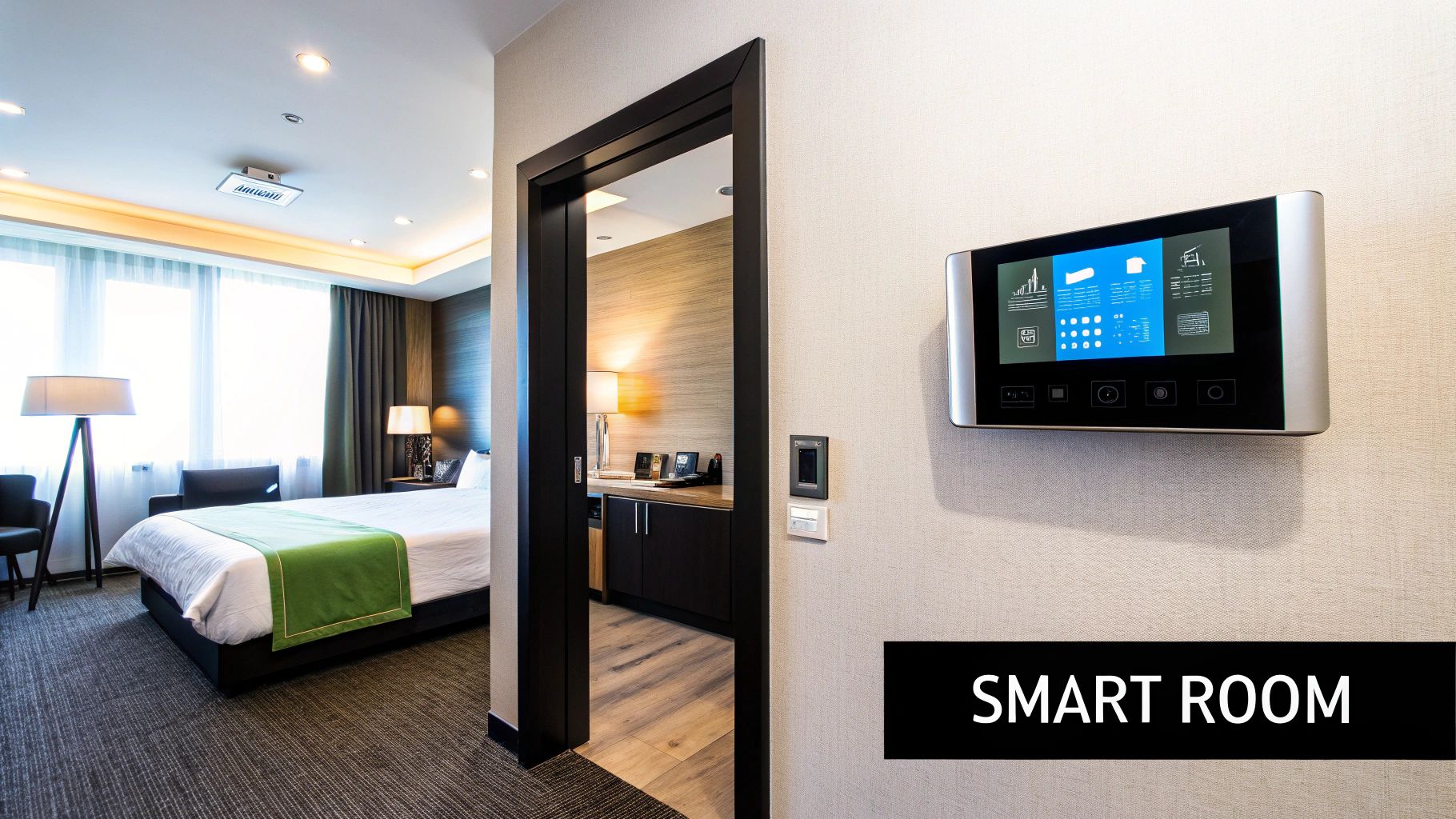
Beyond guest rooms, IoT integration provides powerful tools for predictive maintenance and resource management. Sensors can alert staff to potential equipment failures before they happen, and smart energy systems can significantly reduce utility costs. While often associated with guest-facing solutions, IoT also plays a role in optimizing back-of-house operations, such as through advanced fleet management technologies like Golf Cart GPS Tracking. This comprehensive approach to building automation through IoT is transforming how properties operate.
Real-World Examples
Several innovative brands have embraced IoT to create connected experiences. Marriott's IoT Guestroom Lab allows guests to control lighting, temperature, and curtains with voice commands. Similarly, Wynn Las Vegas has equipped rooms with Amazon Echo devices for smart room control, while citizenM lets guests manage their entire room environment via a tablet.
How to Implement IoT Integration
- Start with Pilot Rooms: Test new IoT devices and systems in a small number of rooms to gather feedback and resolve any technical issues before a full-scale rollout.
- Prioritize Cybersecurity: With more connected devices, a robust security strategy is essential. Ensure all network connections are secure and device software is kept up to date.
- Choose Interoperable Devices: Select technologies that can easily integrate with your existing Property Management System (PMS) and other core systems to create a unified ecosystem.
4. Contactless Payment Solutions
The shift toward contactless payment solutions is one of the most impactful hospitality technology trends, reshaping the entire guest transaction experience. This technology allows guests to pay for services without physical contact, using methods like Near Field Communication (NFC) for tap-to-pay cards, mobile wallets such as Apple Pay and Google Pay, QR codes, and even biometric authentication. Accelerated by a global focus on health and safety, these solutions offer enhanced security, speed, and convenience for everything from check-in to dining and retail purchases.
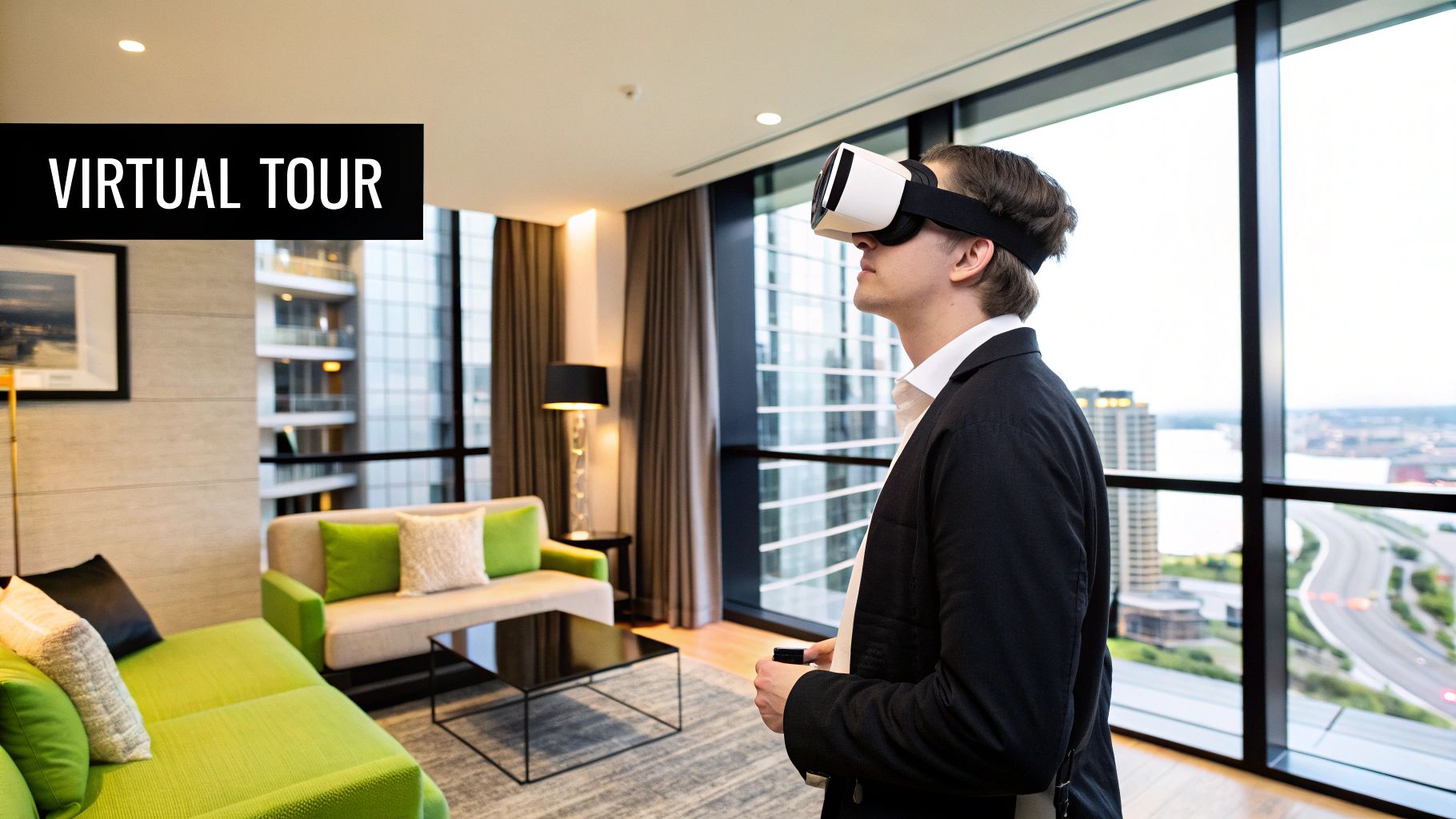
Beyond hygiene, the core benefit is a frictionless guest journey. Contactless payments significantly reduce wait times at the front desk and other points of sale, creating a smoother, more modern experience. For operators, this translates to faster transaction processing, reduced cash handling errors, and improved data security. Integrating these payment options demonstrates a commitment to guest convenience and safety, which directly boosts satisfaction and can lead to increased on-property spending.
Real-World Examples
Major hotel chains like Marriott and Hyatt have widely adopted Apple Pay and Google Pay, allowing guests to pay with a simple tap of their smartphone at check-in and throughout their properties. In Asia, hotels catering to international travelers extensively integrate Alipay and WeChat Pay. Pioneering concepts include grab-and-go shops within hotels that function similarly to Amazon Go, allowing guests to take items and be charged automatically.
How to Implement Contactless Payments
- Offer Multiple Options: Support a variety of methods, including tap-to-pay credit cards, major mobile wallets, and QR codes, to cater to diverse guest preferences.
- Ensure PCI Compliance: Work with your payment processor to guarantee that all hardware and software meet the latest Payment Card Industry (PCI) data security standards to protect guest information.
- Train Staff Thoroughly: Equip your team to guide guests through the new payment processes and troubleshoot common issues, ensuring a seamless experience even when technology falters.
5. Voice-Activated Assistants
Voice-activated assistants are transforming the in-room guest experience, allowing individuals to control their environment and access hotel services using simple voice commands. Smart speakers powered by platforms like Amazon Alexa or Google Assistant integrate with the hotel's property management system and other smart room technologies. Guests can use them to adjust thermostats, control lighting, operate the TV, request housekeeping, or order room service, all without lifting a finger. This hands-free convenience elevates the sense of modern luxury and efficiency.
This trend in hospitality technology goes beyond mere convenience; it acts as a digital concierge. These devices can answer questions about hotel amenities, provide local recommendations, and play music, personalizing the guest's stay in a significant way. For hoteliers, voice assistants streamline service requests, reducing calls to the front desk and allowing staff to fulfill guest needs more efficiently. The data collected can also provide valuable insights into guest preferences and behavior, helping to refine service offerings.
Real-World Examples
The adoption of voice technology is widespread among major brands. Marriott partnered with Amazon to deploy "Alexa for Hospitality" in many of its properties, allowing guests to make service requests and control room features. Similarly, Wynn Las Vegas was an early adopter, equipping thousands of rooms with Amazon Echo devices to create a fully voice-controlled environment.
How to Implement Voice-Activated Assistants
- Provide Clear Privacy Policies: Proactively address guest concerns by clearly communicating how data is used and ensuring that personal conversations are not recorded or stored.
- Offer Voice Command Guides: Place a simple, easy-to-read guide in each room that lists the most common and useful voice commands for controlling the room and accessing services.
- Enable Easy Privacy Controls: Ensure devices have a physical mute button that is easily accessible, giving guests a straightforward way to disable the microphone for complete privacy.
6. Augmented and Virtual Reality
Augmented Reality (AR) and Virtual Reality (VR) are reshaping guest engagement by offering immersive and interactive experiences before, during, and after a stay. VR allows potential guests to take 360-degree virtual tours of hotel rooms, event spaces, and amenities from anywhere in the world, influencing booking decisions with a powerful "try before you buy" approach. AR, on the other hand, enhances the real world by overlaying digital information, turning a standard hotel visit into an interactive adventure.
These hospitality technology trends are not just marketing gimmicks; they are powerful tools for enhancing the guest experience and streamlining operations. From AR-powered wayfinding that guides guests through a large resort to VR-based training modules for staff, the applications are vast. Exploring innovative guest experiences, we see promising advancements in fields such as Virtual Reality applications, which can transport guests to simulated local attractions or provide in-room entertainment that sets a property apart from its competitors.
Real-World Examples
Several forward-thinking hospitality brands are leveraging this technology. Best Western allows guests to take VR tours of their properties, complete with interactive elements. Thomas Cook created VR travel experiences that let customers "visit" destinations before booking a holiday. Similarly, Shangri-La developed AR city guides that bring local landmarks to life through a smartphone camera, enhancing the travel experience.
How to Implement AR and VR
- Start with Simple AR Applications: Begin with a manageable project, like creating an AR-enhanced menu where guests can see a 3D model of a dish by scanning a QR code.
- Focus on Marketing and Training: Prioritize use cases that deliver a clear return on investment, such as virtual tours for event planners or immersive safety training for new employees.
- Ensure High-Quality Content: Poorly produced VR or AR content can be disorienting and reflect negatively on your brand. Invest in professional development to create a seamless and impressive experience.
7. Robotic Service Automation
Robotic Service Automation is one of the most visible and futuristic hospitality technology trends, moving from novelty to practical application. Hotels are deploying autonomous robots to handle repetitive and labor-intensive tasks such as room service delivery, luggage transport, and cleaning. These machines operate independently, navigating hallways and elevators to efficiently serve guests, reduce operational bottlenecks, and free up human staff for more personalized, high-value interactions.
The primary benefit of robotic automation is the significant improvement in operational efficiency and consistency. Robots can work around the clock without breaks, ensuring that guest requests for towels or late-night snacks are fulfilled promptly. This not only enhances the guest experience by providing quick and reliable service but also allows hotels to reallocate labor resources to areas that require a human touch, such as front-desk relations and concierge services, creating a more balanced and effective workforce.
Real-World Examples
The application of service robots is already widespread. Aloft Hotels' "Botlr" was a pioneering delivery robot that transported items to guest rooms. Japan's Henn-na Hotel famously employed a nearly all-robot staff for check-in and concierge duties. Additionally, brands like Holiday Inn Express have tested robotic vacuum cleaners for housekeeping, while the Pepper robot from SoftBank Robotics can be found in hotel lobbies worldwide, greeting guests and providing information.
How to Implement Robotic Automation
- Start with Simple, High-Volume Tasks: Begin by deploying robots for straightforward functions like delivering amenities or room service. This provides a clear return on investment and minimizes operational disruption.
- Ensure Proper Staff Training: Train your team to work alongside the robots, manage their operations, and explain their function to guests. This integration is key to a smooth rollout.
- Plan for Maintenance and Support: Establish a clear plan for technical support and routine maintenance to prevent downtime and ensure the robots operate reliably.
- Market as an Experience Enhancement: Position the robots not as staff replacements but as a unique, modern amenity that enhances the guest experience and adds a memorable touch to their stay.
8. Cloud-Based Property Management Systems
The shift from on-premise to cloud-based property management systems (PMS) is one of the most transformative hospitality technology trends. Cloud-based PMS solutions offer unparalleled flexibility, allowing staff to manage reservations, check-ins, billing, and housekeeping from any device with an internet connection. This eliminates the need for expensive on-site servers, reduces IT maintenance costs, and ensures data is securely backed up and accessible in real-time.
A key advantage of cloud technology is its scalability and integration potential. These systems can easily connect with other essential tools like channel managers, booking engines, and CRM platforms, creating a unified operational ecosystem. This interconnectivity provides a holistic view of the business, enabling data-driven decisions that enhance efficiency and the guest experience. For hoteliers aiming to streamline operations and adapt quickly to market changes, a robust hotel PMS integration strategy is no longer optional; it's essential.
Real-World Examples
The market is led by powerful and versatile platforms. Oracle Hospitality's OPERA Cloud offers a comprehensive suite of tools for large hotel chains, while Cloudbeds provides an all-in-one solution popular with independent hotels and B&Bs. Other notable systems include RoomKeyPMS and Little Hotelier, which cater to specific segments of the market with user-friendly interfaces and robust features.
How to Implement a Cloud-Based PMS
- Evaluate Integration Needs: Before choosing a system, list all the third-party tools you rely on (booking engines, POS systems, etc.) and ensure the PMS offers seamless integrations.
- Plan for Data Migration: Work closely with your chosen provider to create a detailed plan for migrating guest data, reservation history, and financial records from your old system to the new one.
- Train Staff Thoroughly: A new system is only as good as the team using it. Invest in comprehensive training for all staff members, from the front desk to management, to ensure a smooth transition and full adoption.
9. Revenue Management AI
Artificial Intelligence has transformed one of the most critical aspects of hotel operations: revenue management. AI-powered revenue management systems analyze vast datasets, including historical booking patterns, market demand, competitor pricing, and even local events or flight schedules. These sophisticated algorithms automate dynamic pricing, adjusting room rates in real-time to capitalize on demand fluctuations and maximize occupancy and revenue. This data-driven approach moves far beyond static, seasonal pricing models.
This technology empowers hotels to make more strategic, profitable decisions with unparalleled accuracy. By forecasting demand with greater precision, managers can optimize pricing not just for rooms but for amenities and packages, ensuring they capture the maximum potential revenue from every guest. Integrating AI into this core function is a pivotal one of the modern hospitality technology trends, allowing properties to stay competitive in a rapidly changing market. This automation also frees up revenue managers to focus on high-level strategy rather than manual data analysis.
Real-World Examples
Leading platforms in this space showcase the power of AI in revenue optimization. IDeaS Revenue Solutions is widely used by major chains like Hilton and IHG to automate pricing decisions across their portfolios. Similarly, platforms like Duetto and Atomize offer cloud-based systems that provide hoteliers with real-time pricing recommendations and deep analytical insights to outperform their competition.
How to Implement Revenue Management AI
- Start with Historical Data Analysis: Before full implementation, use the AI tool to analyze at least 1-2 years of your property's historical booking and pricing data to establish a strong performance baseline.
- Set Pricing Boundaries: Configure clear minimum and maximum rate parameters within the system. This ensures the AI operates within your brand's pricing strategy and prevents unrealistic rate suggestions.
- Monitor Competitor Strategies: Leverage the system's competitor analysis tools but don't follow them blindly. Use the data to inform your strategy, not dictate it, maintaining your unique market position.
- Conduct Regular Performance Reviews: Schedule weekly or bi-weekly meetings to review the AI's pricing decisions and their impact on revenue. Use these insights to fine-tune the system's rules and parameters over time.
Hospitality Tech Trends Comparison Matrix
| Technology | 🔄 Implementation Complexity | 🛠️ Resource Requirements | 📊 Expected Outcomes | 🎯 Ideal Use Cases | ⭐ Key Advantages | 💡 Tips & Insights |
|---|---|---|---|---|---|---|
| Artificial Intelligence and Chatbots | Medium to High (ongoing training) | AI platform, data integration | Automated 24/7 support, faster response | Customer service automation, reservation handling | Consistent service, cost reduction, data insights | Start with FAQ automation, seamless human handoff, continuous updates |
| Mobile Key Technology | Medium (hardware/software setup) | Mobile-compatible devices, infrastructure | Enhanced convenience, security tracking | Contactless room access, reducing front desk bottlenecks | Guest convenience, reduced physical contact, eco-friendly | Clear setup instructions, backup keys, ensure Wi-Fi coverage |
| Internet of Things (IoT) Integration | High (complex integration) | IoT devices, cybersecurity, technical expertise | Energy efficiency, personalized environment | Smart rooms, predictive maintenance | Energy savings, guest comfort, operational insights | Pilot testing, prioritize security, staff training |
| Contactless Payment Solutions | Medium (infrastructure & compliance) | Payment gateways, NFC/biometric tech | Faster transactions, improved hygiene | Point of sale, guest payments | Speed, security, hygiene improvement | Multiple payment options, clear signage, PCI compliance |
| Voice-Activated Assistants | Medium (device integration, privacy) | Smart speakers, voice AI platform | Hands-free control, accessibility | Room controls, on-demand services | Accessibility, reduced touchpoints, guest engagement | Clear privacy policies, user guides, privacy controls |
| Augmented and Virtual Reality | High (content creation, hardware) | AR/VR devices, development resources | Immersive marketing & training | Guest experience enhancement, staff training | Unique engagement, marketing appeal, booking increase | Start simple, focus on marketing/training, ensure comfort |
| Robotic Service Automation | High (hardware, programming) | Service robots, maintenance teams | Labor cost reduction, consistent service | Delivery, cleaning, concierge services | 24/7 operation, guest attraction, hygiene | Start with simple tasks, train staff, plan maintenance |
| Cloud-Based Property Management Systems | Low to Medium (cloud setup, migration) | Internet access, IT support | Scalable management, real-time data | Multi-property management, scalable PMS | Lower IT costs, remote access, automatic backups | Reliable internet, data migration planning, staff training |
| Revenue Management AI | High (data-driven, algorithmic) | AI software, market data access | Optimized pricing, revenue maximization | Pricing strategy, demand forecasting | Increased revenue, data-driven decisions, competitive edge | Use historical data, monitor competitors, set pricing boundaries |
Integrating Tomorrow’s Tech for Today’s Guests
The hospitality landscape is undergoing a profound transformation, driven by a powerful fusion of guest expectations and technological innovation. As we've explored, the journey from AI-powered chatbots and cloud-based PMS to the seamless convenience of mobile keys and IoT-integrated rooms is not just about adopting new gadgets. It’s about fundamentally reshaping the guest experience into one that is hyper-personalized, ultra-efficient, and deeply connected.
These emerging hospitality technology trends are more than individual tools; they are interconnected components of a new digital ecosystem. A voice assistant ordering room service relies on a smart room’s IoT network. A contactless payment system integrates with the cloud-based PMS. Success is no longer defined by offering one or two of these innovations, but by creating a cohesive, frictionless environment where they work in harmony to anticipate and exceed guest needs at every touchpoint.
Weaving Technology into Your Operational Fabric
Moving forward requires a strategic mindset. The goal is not simply to implement technology for its own sake, but to solve real-world challenges, whether it's streamlining check-in, personalizing marketing efforts with AI, or optimizing room energy usage through smart controls. This strategic adoption is the key to achieving a tangible return on investment and building lasting guest loyalty in an increasingly competitive market.
To translate these trends into reality, consider these actionable next steps:
- Audit Your Current Infrastructure: Before investing in new tech, evaluate your existing network, Wi-Fi capabilities, and security protocols. Can your current setup support the demands of IoT devices, cloud software, and high-speed guest connectivity?
- Prioritize for Impact: You don't need to adopt everything at once. Analyze your guest feedback and operational bottlenecks. Would mobile keys solve front-desk congestion? Could an AI chatbot free up staff to handle more complex guest requests? Start with the technology that delivers the most significant impact.
- Focus on Integration: Select solutions that can communicate with each other. A powerful, integrated tech stack prevents data silos and ensures a smooth, uninterrupted experience for both your staff and your guests. This is where a robust, centralized platform becomes invaluable.
The common thread weaving through all these advancements is the critical need for a powerful, secure, and impeccably managed technological foundation. Without it, even the most impressive guest-facing technology will falter. The future of hospitality belongs to those who not only embrace these trends but also build the resilient infrastructure required to support them. By doing so, you position your property not just to compete, but to lead the charge in defining the next generation of exceptional guest experiences.
Ready to build the powerful, reliable technology foundation your property needs to thrive? Discover how Clouddle Inc provides comprehensive managed IT, networking, and security solutions designed specifically for the hospitality industry. Visit Clouddle Inc to learn how our expert services can seamlessly power your adoption of the latest hospitality technology trends.


